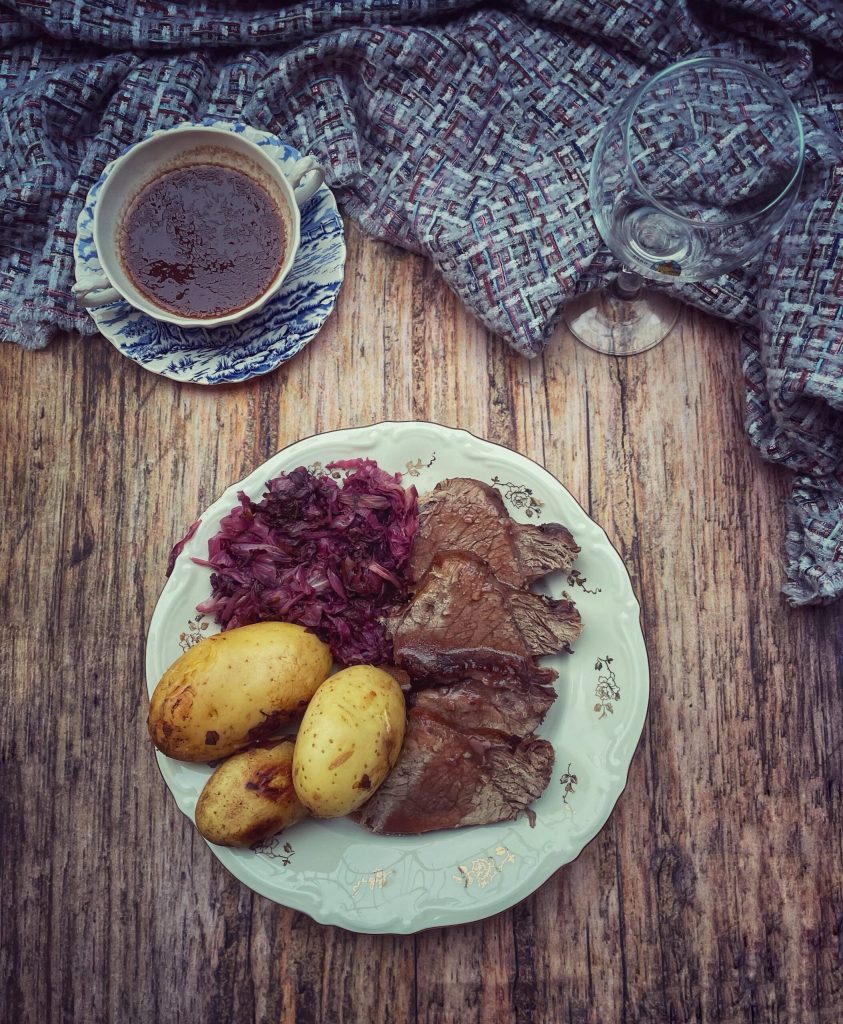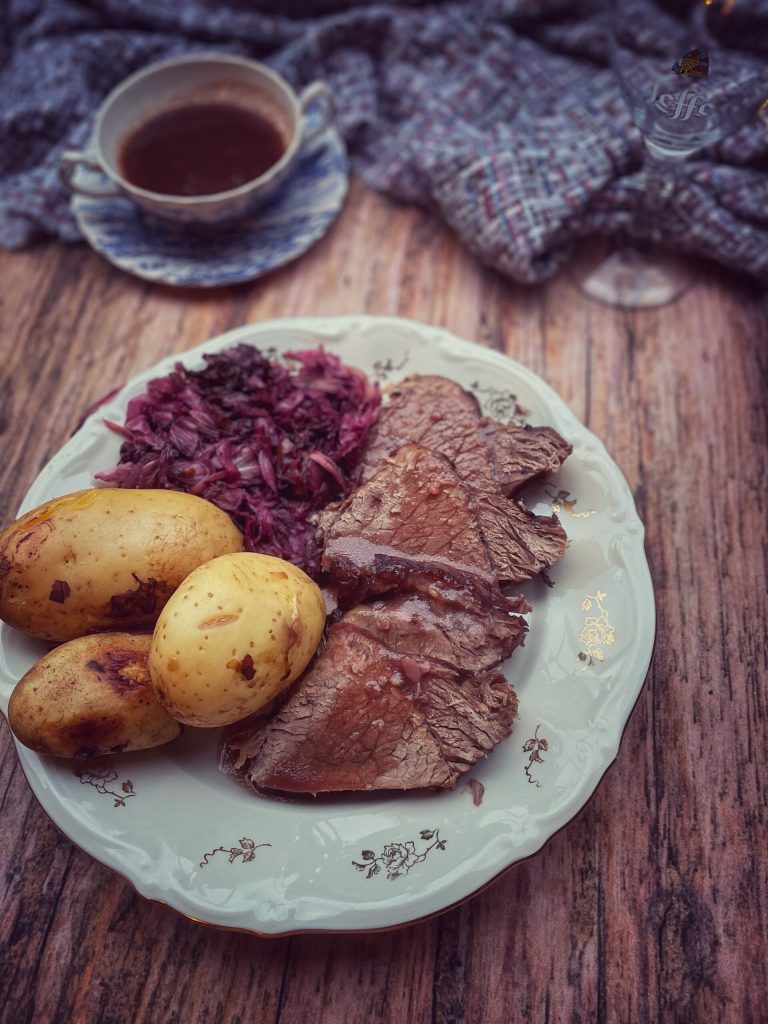The Sauerbraten is a traditional German marinated roast considered the national dish of Germany.
It can be cooked with a variety of meats, most often beef, but also chicken, lamb and mutton, pork, and horse.
Usually, tougher cuts are used, like the rump roast or bottom round of beef.
Before cooking, the meat is marinated for 3-15 days in a mixture of wine and/or vinegar, water, herbs, spices, and vegetables like onions, celery, and carrots.
Sauer means “sour” or “pickled” and Braten means “roast,” therefore “sour roast.”
The ingredients used in the marinade and the sides served with sauerbraten vary by region.
A Sauerbraten meal is almost always accompanied by a substantial gravy from its roasting and often served with potato pancakes (Kartoffelpuffer), potato dumplings (Kartoffellöß), or Spätzle, stewed red cabbage in vinegar or boiled potatoes.
In the video, the TikTok live of June 24, 2025, when I prepared the Sauerbraten recipe.

- Difficulty: Medium
- Cost: Medium
- Rest time: 3 Days
- Preparation time: 20 Minutes
- Portions: 6People
- Cooking methods: Stovetop, Oven
- Cuisine: German
- Seasonality: All seasons
Ingredients
- 2 onions
- 1 carrot
- 1.25 cups red wine vinegar (or apple cider vinegar)
- 1 stalk celery
- 1.25 cups red wine
- 2 cups water (or broth)
- 2 tablespoons sugar
- 4 leaves bay
- 8 berries juniper
- 6 grains black pepper
- 4 cloves
- 3.3 lbs beef (rump roast or bottom round)
- as needed butter
Tools
- 1 spice bag
Steps
Prepare the marinade
Chop onions, carrot, and celery into coarse pieces. Bring vinegar, wine, water, sugar, tomato paste, vegetables, and spices to a boil. Let it cool.
Salt and pepper the meat, place it in a container and cover it with the cold marinade. Marinate in the fridge for at least 2-5 days (traditionally 3 days).Remove the meat from the marinade, dry it. Sear it well on all sides in clarified butter.
Return the meat with part of the strained marinade to a covered casserole. Cook in the oven at 300-320°F (or over low heat on the stovetop) for 2 hours, turning it occasionally.Prepare the sauce
Strain the cooking liquid. You can blend the vegetables or keep them whole.Reduce the sauce over the heat and adjust with salt, pepper, and a bit of flour or starch. You can thicken it with butter or spiced breadcrumbs (German Soßenlebkuchen).
Note: After the roast is cooked, the marinade is strained and returned to a saucepan and often thickened with crumbled gingerbread, lebkuchen, or ginger cookies, flour, sour cream, brown sugar, and/or roux, which add body and flavor to the sauce.

As you can see in the video, I opted for oven cooking using my CookUt – dutch oven
Tip for marinating:
It is often recommended to marinate the meat in a terracotta, glass, plastic or enamel container rather than a bare metal one, as the acidic marinade would react with a metal container during prolonged marinating.
It is often recommended to marinate the meat in a terracotta, glass, plastic or enamel container rather than a bare metal one, as the acidic marinade would react with a metal container during prolonged marinating.
Packaged seasonings for sauerbraten are available. In some German supermarkets, cooked and marinated sauerbraten can be found.
FAQ (Frequently Asked Questions)
What is the history of Sauerbraten?
Julius Caesar is credited with inspiring the sauerbraten by sending amphoras filled with beef marinated in wine across the Alps to the nascent Roman colony of Cologne.
According to this legend, it inspired the people of Cologne to imitate the Roman import. Despite being quite common, these claims are largely unfounded.
Several sources claim that the sauerbraten was invented by Charlemagne in the 9th century AD as a way to use leftover roasted meat.
Saint Albert the Great, also known as Saint Albert the Great and Albert of Cologne, is credited with popularizing the dish in the 13th century.
Originally, horse meat was not used for the dish, although it has become commonly used in Rhenish restaurants.
In most other areas where the dish is found, beef is currently used.What are the regional variations of Sauerbraten?
There are many regional variations of sauerbraten.
Many of the variations concern the ingredients used for the marinating.
Generally, the base of the marinade is red wine, vinegar or a combination of both.
While Germany mainly produces white wines like Riesling and Gewürztraminer, the German regions closer to France often use red wine as the base for the marinade.
Wine vinegar, apple cider vinegar, and other varieties can be used as the base.
The recipes from the eastern regions of Germany, closer to Poland and the Czech Republic, tend to use vinegar as the base more frequently.
The Rheinischer Sauerbraten is prepared in the German region of Rhineland, along the Rhine valley. During cooking, raisins and sometimes beet syrup are added to give sweetness and complement the acidity of the marinade.

